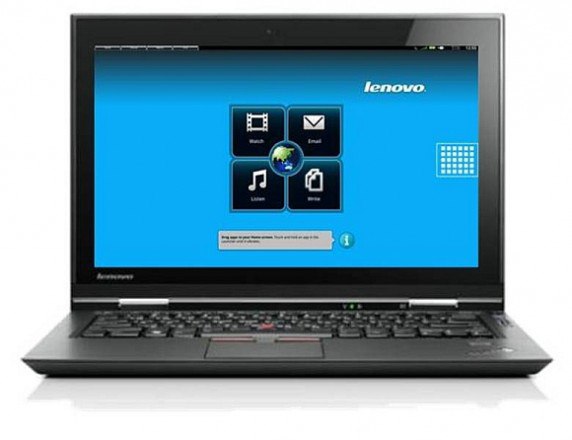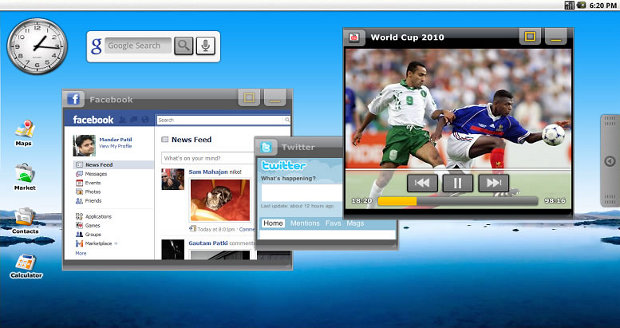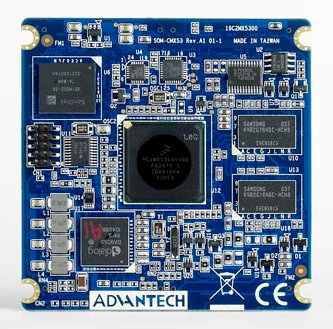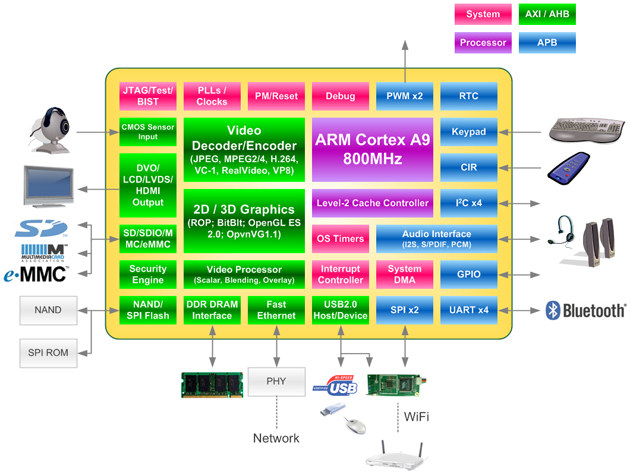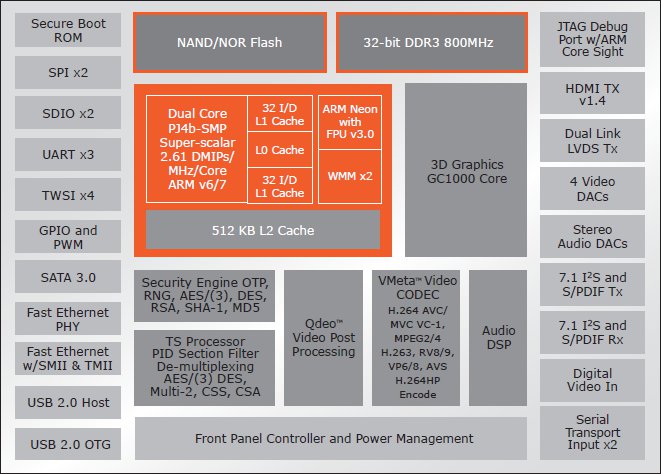CES 2012 is almost there. Yesterday, Acer introduced its new Android Tablet based on the quad core Nvidia Tegra 3 @ 1.3 Ghz, with a 10.1″ capacitive touchscreen (1920×1200) and running Android 4.0. Acer Iconia A700 comes with Bluetooth support, a microSD card slot, HDMI port and a 5MP rear camera. Acer customized the UI with Acer Ring, a circular launcher menu that lets you access specific apps straight from the lock screen. although this is still broadly Android 4.0. As we could expect, Android runs pretty smoothly with the Tegra 3. The 1920×1200 resolution allows to play 1920×1080 (1080p) videos and have the Android menu bar at the bottom of the screen at the same time without scaling the video. The device is expected to ship in Q1 2012 for an undisclosed price.
Intel or ARM NoteBook? Lenovo Says Both
Lenovo has announced the ThinkPad X1 Hybrid notebook which features an Intel Core processor (i3, i5, or i7 depending on the model) AND a Qualcomm Dual core ARM processor, allegedly a Qualcomm APQ8060 and runs both Windows 7 and a custom version of Linux. My first reaction when I read the news was: “What a stupid idea!” :~/ The ThinkPad X1 Hybrid has 13.3″ HD display with 1366×768 resolution and built with Gorilla Glass. The laptop also features an HD webcam, a fingerprint reader, an encrypted hard disk drive, an HDMI port, USB ports, and Intel’s Wireless Display (WiDi) technology. RapidCharge technology charges to 80% capacity in 30 minutes, i.e. approximately the time it takes to take a shower and cook an egg… (Not my idea, see promo video below). The only thing that can possibly justify having two different processors on the machine is the Instant Media Mode (IMM) […]
Wind River Unveils Android User Experience, Connectivity and Medical Modules.
Wind River has introduced Wind River Solution Accelerators for Android, a series of software modules to help developers jumpstart their Android development and rapidly integrate compelling features and functionalities to their devices. Wind River Solution Accelerators for Android are currently available in three software modules: User Experience: Accelerated boot time technologies including Hyper boot enabling devices to resume from RAM in less than 1 second and from Flash in 8 seconds. This technology can speed up the Android boot time by 30%. It is hardware agnostic and can run on different hardware platforms with little or no customization effort. Multi-windowing screen navigation aimed at devices with larger screens such as tablets, automotive infotainment systems, media phones, and industrial devices. The application windows are sized based on the remaining portion of the visible screen and users can minimize, resize, and arrange them as they wish. (See Picture on top) Media Center […]
Archos G9 Tablets Will Officially Get Android 4.0
Back in December, a demo of Android 4.0 running on Archos 80 G9 was published. Today Archos has officially announced that Android 4.0 would be available very soon for all Archos G9: Archos 80 G9 and Archos 101 G9 including the Turbo version in their Facebook account: Who’s Hungry for ICE CREAM SANDWICH? All ARCHOS G9’s (both current and future) will receive an official upgrade to ICS (ANDROID 4.0) in the near future. With ARCHOS, your device will have full ICS including access to the Google Market, Google Suite of Apps and DRM Support There won’t be any official update for Archos G8 and if you have such device, you’ll have to stay with Android 2.2 for now. If you really need Android 2.3 (Gingerbread) on your Archos Generation 8 (e.g. Archos 70IT), you’ll have to use CyanogenMod CM7 ROM.
Advantech ROM-1210 Computer on Module Powered by Freescale i.MX53
Advantech announced today a new Computer On Module (COM), the ROM-1210, powered by Freescale i.MX53 Cortex-A8 Processor clocked at 1 Ghz, with 256 to 512MB DDR3 onboard, 2GB Flash (upgradable to 64 GB) and supporting OpenGL ES 2.0, OpenVG 1.1 hardware 2D/3D accelerators. The module also supports full HD 1080p video decoding and HD 720p video encoding via its hardware engine. The company targets human machine interface (HMI), digital signage, industrial automation, cloud computing and portable applications with this platform that can run Android 2.3, embedded Linux 2.6 and Windows Embedded Compact 7. Here are ROM-1210 specifications: CPU – Freescale i.MX535 Cortex-A8 1GHz (i.MX536 Cortex-A8 800MHz for wide temp. only) System RAM – 512 MB DDR3 (256 MB as optional) Flash – 2 GB (up to 64 GB) Graphic Chip – 24-bit LCD controller by CPU. Resolution Default 800×480 WVGA (320X 240 ~ 1920X1080 as optional) LCD Interface – 2x […]
WonderMedia Prizm WM8950 Cortex A9 SoC
WonderMedia Technologies, a subsidiary of Via Technologies, has unveiled the Prizm WM8950, a single core Cortex A9 processor running up to 800 Mhz with a Mali-400 GPU. The WM8950 SoC is especially aimed at low cost tablets running Android 4.0 as well as WinCE 7.0 smartbooks, but the company says it would also be suitable for applications such as Smart TV, SmartStream for wireless display and multimedia streaming, networked projectors, digital signage and thin clients. Peripheral support includes HDMI, LVDS, and DVO video interfaces, CMOS sensor input for webcams and SD / e-MMC card support.. Additional I/O includes 10/100 Ethernet, USB 2.0, audio, SPI, I2C, UARTs and GPIO. Wi-Fi and Bluetooth can be supported with external chips via SPI and UART interfaces. PRIZM WM8950 Key Features: 800MHz ARM Cortex-A9 processor ARM Mali-400 3D graphics Processor Multi-standard 1080p video decoding engine H.264 video encoding DDR3/LPDDR2 DRAM interface Multiple video interface including […]
Linux 3.2 Release
Linux Torvalds announced the release of Linux Kernel 3.2 on the 4th of January: So 3.2 is out, and the merge window for 3.3 is thus officially open. I delayed 3.2 first a few days to wait for the final linux-next (“final” in the sense that that’s what I’ll fetch to decide whether something has been in linux-next for 3.3 or not), and then some more as people were coming back from holidays and sorting out some regressions. So we do have a few last-minute reverts and small fixes. Still, there’s not a whole lot of changes since -rc7 (shortlog appended), and almost all of them are *tiny*. So despite the few annoying last-minute reverts, I’m feeling pretty happy about it. Linus Linux 3.1 added support for OpenRISC, Near-Field Communication (NFC) and new power tuning tools called cpupowerutils, as well as support for Xilinx boards and i.MX53 ARD. Linux 3.2 […]
Marvell Armada 1500 Google TV Reference Design
Marvell announced that its Foresight Platform, powered by Marvell ARMADA 1500 HD Secure Media Processor System-on-a-Chip (SoC), will be officially used by Google TV (replacing Intel CE4100 SoC) and be introduced at CES 2012. The company said Google TV smart TVs, set-top boxes (STB) and blu-ray players based on its platform would be available later this year. The Foresight Platform uses Marvell’s Qdeo video processing technology designed to deliver improved 3D video, rich audio, 3D graphics and TV-friendly Web content thanks to noise reduction, de-interlacing, low bit-rate internet video enhancement and other enhancement techniques such as Adaptive Contrast Enhancement (ACE) and Intelligent Color Remapping (ICR). ARMADA 1500 (codenamed 88DE3100) contains Marvell’s ARM v6/7-compatible PJ4B SMP super-scalar dual-core CPU. The chip is designed to enable PC-like processing power to support Web browsing with support for Flash and other key technologies – with the aid of more than 6000 Dhrystone MIPS of […]


